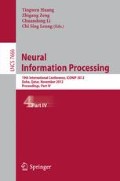Abstract
This paper proposes to use a Liquid State Machine (LSM) to classify inertial sensor data collected from horse riders into activities of interest. LSM was shown to be an effective classifier for spatio-temporal data and efficient hardware implementations on custom chips have been presented in literature that would enable relative easy integration into wearable technologies. We explore here the general method of applying LSM technology to domain constrained activity recognition using a synthetic data set. The aim of this study is to provide a proof of concept illustrating the applicability of LSM for the chosen problem domain.
Access this chapter
Tax calculation will be finalised at checkout
Purchases are for personal use only
Preview
Unable to display preview. Download preview PDF.
References
Bao, L., Intille, S.S.: Activity Recognition from User-Annotated Acceleration Data. In: Ferscha, A., Mattern, F. (eds.) PERVASIVE 2004. LNCS, vol. 3001, pp. 1–17. Springer, Heidelberg (2004)
Bohte, S.M., Kok, J.N., Poutré, J.A.L.: Error-backpropagation in temporally encoded networks of spiking neurons. Neurocomputing 48(1-4), 17–37 (2002)
de Garis, H., Nawa, N., Hough, M., Korkin, M.: Evolving an optimal de/convolution function for the neural net modules of atr’s artificial brain project. In: International Joint Conference on Neural Networks, IJCNN 1999, vol. 1, pp. 438–443 (1999)
Gerstner, W., Kistler, W.M.: Spiking Neuron Models: Single Neurons, Populations, Plasticity. Cambridge University Press, Cambridge (2002)
Junker, H., Amft, O., Lukowicz, P., Tröster, G.: Gesture spotting with body-worn inertial sensors to detect user activities. Pattern Recognition 41(6), 2010–2024 (2008)
Lukowicz, P., Ward, J.A., Junker, H., Stäger, M., Tröster, G., Atrash, A., Starner, T.: Recognizing Workshop Activity Using Body Worn Microphones and Accelerometers. In: Ferscha, A., Mattern, F. (eds.) PERVASIVE 2004. LNCS, vol. 3001, pp. 18–32. Springer, Heidelberg (2004)
Maass, W., Natschläger, T., Markram, H.: Real-time computing without stable states: A new framework for neural computation based on perturbations. Neural Computation 14(11), 2531–2560 (2002)
Markram, H., Wang, Y., Tsodyks, M.: Differential signaling via the same axon of neocortical pyramidal neurons. Proceedings of the National Academy of Sciences 95(9), 5323–5328 (1998)
Schliebs, S., Defoin-Platel, M., Kasabov, N.: Integrated Feature and Parameter Optimization for an Evolving Spiking Neural Network. In: Köppen, M., Kasabov, N., Coghill, G. (eds.) ICONIP 2008, Part I. LNCS, vol. 5506, pp. 1229–1236. Springer, Heidelberg (2009)
Schliebs, S., Fiasché, M., Kasabov, N.: Constructing Robust Liquid State Machines to Process Highly Variable Data Streams. In: Villa, A.E.P., Duch, W., Érdi, P., Masulli, F., Palm, G. (eds.) ICANN 2012, Part I. LNCS, vol. 7552, pp. 604–611. Springer, Heidelberg (2012)
Schrauwen, B., Van Campenhout, J.: BSA, a fast and accurate spike train encoding scheme. In: Proceedings of the International Joint Conference on Neural Networks, vol. 4, pp. 2825–2830 (July 2003)
Schrauwen, B., D’Haene, M., Verstraeten, D., Campenhout, J.V.: Compact hardware liquid state machines on fpga for real-time speech recognition. Neural Networks 21(2-3), 511–523 (2008)
Stiefmeier, T., Ogris, G., Junker, H., Lukowicz, P., Troster, G.: Combining motion sensors and ultrasonic hands tracking for continuous activity recognition in a maintenance scenario. In: 2006 10th IEEE International Symposium on Wearable Computers, pp. 97–104. IEEE (2006)
Zhu, R., Zhou, Z.: A real-time articulated human motion tracking using tri-axis inertial/magnetic sensors package. IEEE Transactions on Neural Systems and Rehabilitation Engineering 12(2), 295–302 (2004)
Author information
Authors and Affiliations
Editor information
Editors and Affiliations
Rights and permissions
Copyright information
© 2012 Springer-Verlag Berlin Heidelberg
About this paper
Cite this paper
Schliebs, S., Hunt, D. (2012). Continuous Classification of Spatio-temporal Data Streams Using Liquid State Machines. In: Huang, T., Zeng, Z., Li, C., Leung, C.S. (eds) Neural Information Processing. ICONIP 2012. Lecture Notes in Computer Science, vol 7666. Springer, Berlin, Heidelberg. https://doi.org/10.1007/978-3-642-34478-7_76
Download citation
DOI: https://doi.org/10.1007/978-3-642-34478-7_76
Publisher Name: Springer, Berlin, Heidelberg
Print ISBN: 978-3-642-34477-0
Online ISBN: 978-3-642-34478-7
eBook Packages: Computer ScienceComputer Science (R0)

